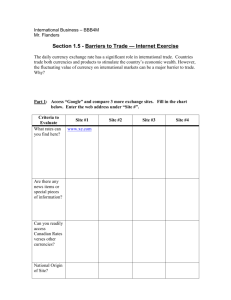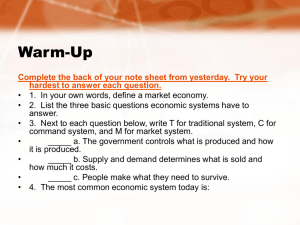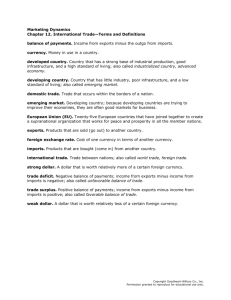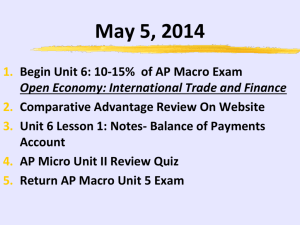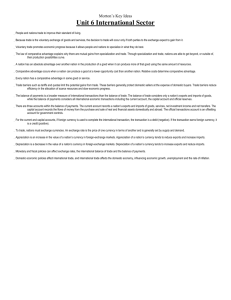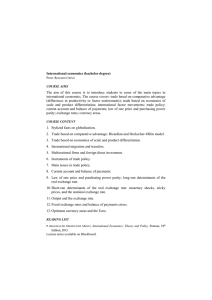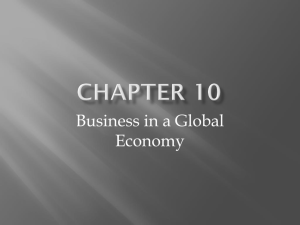Exchange rate systems & policies
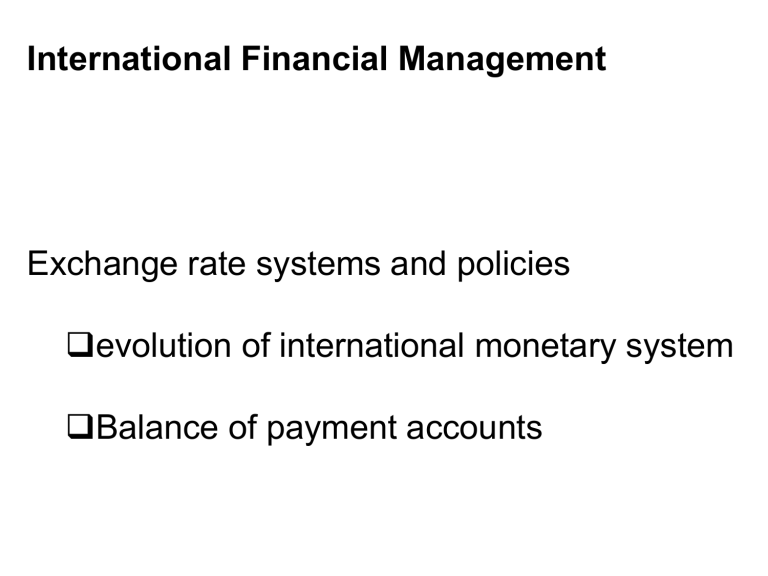
International Financial Management
Exchange rate systems and policies
evolution of international monetary system
Balance of payment accounts
Evolution of the
International Monetary System
• Bimetallism: Before 1875
• Classical Gold Standard: 1875-1914
• Interwar Period: 1915-1944
• Bretton Woods System: 1945-1972
• The Flexible Exchange Rate Regime:
1973-Present
Bimetallism: Before 1875
• A “double standard” in the sense that both gold and silver were used as money.
• Some countries were on the gold standard, some on the silver standard, some on both.
• Both gold and silver were used as international means of payment and the exchange rates among currencies were determined by either their gold or silver contents.
Classical Gold Standard:
1875-1914
• During this period in most major countries:
– Gold alone was assured of unrestricted coinage
– There was two-way convertibility between gold and national currencies at a stable ratio.
– Gold could be freely exported or imported.
• The exchange rate between two country’s currencies would be determined by their relative gold contents.
Classical Gold Standard:
1875-1914
For example, if the dollar is pegged to gold at U.S.$30 = 1 ounce of gold, and the
British pound is pegged to gold at £6 = 1 ounce of gold, it must be the case that the exchange rate is determined by the relative gold contents:
$30 = £6
$5 = £1
Classical Gold Standard:
1875-1914
• Highly stable exchange rates under the classical gold standard provided an environment that was conducive to international trade and investment.
• Misalignment of exchange rates and international imbalances of payment were automatically corrected.
Classical Gold Standard:
1875-1914
• There are shortcomings:
– The supply of newly minted gold is so restricted that the growth of world trade and investment can be hampered for the lack of sufficient monetary reserves.
– Even if the world returned to a gold standard, any national government could abandon the standard.
Interwar Period: 1915-1944
• Exchange rates fluctuated as countries widely used “predatory” depreciations of their currencies as a means of gaining advantage in the world export market.
• Attempts were made to restore the gold standard, but participants lacked the political will to “follow the rules of the game”.
• The result for international trade and investment was extremely harmful.
Bretton Woods System:
1945-1972
• Named for a 1944 meeting of 44 nations at Bretton Woods, New Hampshire.
• The purpose was to design a postwar international monetary system.
• The goal was exchange rate stability without the gold standard.
• The result was the creation of the IMF and the World Bank.
Bretton Woods System:
1945-1972
• Under the Bretton Woods system, the
U.S. dollar was pegged to gold at $35 per ounce and other currencies were pegged to the U.S. dollar.
• Each country was responsible for maintaining its exchange rate within ± 1% of the adopted par value by buying or selling foreign reserves as necessary.
• The Bretton Woods system was a dollarbased gold exchange standard.
The Flexible Exchange Rate
Regime: 1973-Present.
• Flexible exchange rates were declared acceptable to the IMF members.
– Central banks were allowed to intervene in the exchange rate markets to iron out unwarranted volatilities.
• Gold was abandoned as an international reserve asset.
• Non-oil-exporting countries and lessdeveloped countries were given greater access to IMF funds.
European Monetary System
• Eleven European countries maintain exchange rates among their currencies within narrow bands, and jointly float against outside currencies.
• Objectives:
– To establish a zone of monetary stability in
Europe.
– To pave the way for the European Monetary
Union.
What Is the Euro?
• The euro is the single currency of the
European Monetary Union which was adopted by 11 Member States on 1
January 1999.
• These member states are: Belgium,
Germany, Spain, France, Ireland, Italy,
Luxemburg, Finland, Austria, Portugal and the Netherlands.
EURO CONVERSION RATES
1 Euro is Equal to:
40.3399 BEF
1.95583 DEM
166.386 ESP
6.55957 FRF
.787564 IEP
1936.27 ITL
40.3399 LUF
2.20371 NLG
13.7603 ATS
200.482 PTE
5.94573 FIM
Belgian franc
German mark
Spanish peseta
French franc
Irish punt
Italian lira
Luxembourg franc
Dutch gilder
Austrian schilling
Portuguese escudo
Finnish markka
What is the official sign of the euro?
The sign for the new single currency looks like an “E” with two clearly marked, horizontal parallel lines across it.
It was inspired by the Greek letter epsilon, in reference to the cradle of European civilization and to the first letter of the word 'Europe'.
How will the euro affect contracts denominated in national currency?
• All insurance and other legal contracts will continue in force with the substitution of amounts denominated in national currencies with their equivalents in euro.
• Euro values calculate according to the fixed conversion rates with the national currency unit adopted on 1 January 1999.
• Generally, the conversion to the euro was taken place on 1 January 2002.
The Mexican Peso Crisis
• On 20 December, 1994, the Mexican government announced a plan to devalue the peso against the dollar by 14 percent.
• This decision changed currency trader’s expectations about the future value of the peso.
• They stampeded for the exits.
• In their rush to get out the peso fell by as much as 40 percent.
The Mexican Peso Crisis
• The Mexican Peso crisis is unique in that it represents the first serious international financial crisis touched off by cross-border flight of portfolio capital.
• Two lessons emerge:
– It is essential to have a multinational safety net in place to safeguard the world financial system from such crises.
– An influx of foreign capital can lead to an overvaluation in the first place.
The Asian Currency Crisis
• The Asian currency crisis turned out to be far more serious than the Mexican peso crisis in terms of the extent of the corruption and the severity of the resultant economic and social costs.
• Many firms with foreign currency bonds were forced into bankruptcy.
• The region experienced a deep, widespread recession.
Currency Crisis Explanations
• In theory, a currency’s value mirrors the fundamental strength of its underlying economy, relative to other economies. In the long run .
• In the short run , currency trader’s expectations play a much more important role.
• In today’s environment, traders and lenders, using the most modern communications.
• Thus, fears of depreciation become self-fulfilling prophecies.
Alternative Exchange Rate Systems
Free Float
Managed Float
Target-Zone Arrangements
Fixed-Rate System
Hybrid System
Free Float
Market exchange rates are determined by the interaction of currency supplies and demand.
Equilibrium price for DEM in terms of USD
USD price of one DEM
S t e t
D t
Quantity of DEM
Managed Float
Most countries with floating currencies have attempted, via Central Bank intervention, to smooth out exchange rate fluctuations.
Main distinct categories of Central Bank intervention
Smoothing out daily fluctuations
Leaning against the wind
Unofficial pegging
Target-Zone Arrangement
Countries adjust their national economic policies to maintain their exchange rates within a specific margin around agreed upon, fixed central exchange rates. (Eg.
European Monetary System – EMS.
Fixed Rate System
Governments are committed to maintain target exchange rates. Each Central Bank actively buys or sells its currency in the foreign exchange market.
Policy alternatives
Foreign borrowings
Austerity
Wages & price controls
Exchange controls
Hybrid System
Current Exchange Rate
Arrangements
• Free Float
– The largest number of countries, about 48, allow market forces to determine their currency’s value.
• Managed Float
– About 25 countries combine government intervention with market forces to set exchange rates.
• Pegged to another currency
– Such as the U.S. dollar or euro (through franc or mark).
Balance of Payments
Accounting
• The Balance of Payments is the statistical record of a country’s international transactions over a certain period of time presented in the form of double-entry bookkeeping.
N.B. when we say “a country’s balance of payments” we are referring to the transactions of its citizens and government .
Balance of Payments Accounts
• The balance of payments accounts are those that record all transactions between the residents of a country and residents of all foreign nations.
• They are composed of the following:
– The Current Account
– The Capital Account
– Statistical Discrepancy
– The Official Reserves Account
The Current Account
• Includes all imports and exports of goods and services.
• Includes unilateral transfers of foreign aid.
• If the debits exceed the credits, then a country is running a trade deficit .
The Capital Account
• The capital account measures the difference between home country’s sales of assets to foreigners and purchases of foreign assets.
• The capital account is composed of
Foreign Direct Investment (FDI), portfolio investments and other investments.
Statistical Discrepancy
• There’s going to be some omissions and misrecorded transactions —so we use a “plug” figure to get things to balance.
• Given example shows a discrepancy of 96.76 billion in 2XXX.
The Official Reserves Account
• Official reserves assets include gold, foreign currencies, reserve positions in the IMF.
The Balance of Payments
Identity
BCA + BKA + BRA = 0 where
BCA = balance on current account
BKA = balance on capital account
BRA = balance on the reserves account
Under a pure flexible exchange rate regime,
BCA + BKA = 0
XYZ Balance of Payments Data
Current Account
1 Exports
2 Imports
3 Unilateral Transfers
Balance on Current Account
Capital Account
4 Direct Investment
5 Portfolio Investment
6 Other Investments
Balance on Capital Account
7 Statistical Discrepancies
Overall Balance
Official Reserve Account
Credits
1,167.61
6.13
107.93
387.62
194.95
264.58
1.02
Debits
(1,295.53)
(45.01)
(166.80)
(119.44)
(79.28)
(227.2)
(96.76)
(1.02)
XYZ Balance of Payments Data
Current Account
1 Exports
2 Imports
3 Unilateral Transfers
Balance on Current Account
Capital Account
4 Direct Investment
5 Portfolio Investment
6 Other Investments
Balance on Capital Account
7 Statistical Discrepancies
Overall Balance
Official Reserve Account
Credits
1,167.61
6.13
107.93
387.62
194.95
264.58
1.02
Debits
(1,295.53)
(45.01)
(166.80)
(119.44)
(79.28)
(227.2)
(96.76)
(1.02)
In 2XXX, the
XYZ imported more than it exported, thus running a current account deficit of 166.8 billion.
XYZ Balance of Payments Data
Current Account
1 Exports
2 Imports
3 Unilateral Transfers
Balance on Current Account
Capital Account
4 Direct Investment
5 Portfolio Investment
6 Other Investments
Balance on Capital Account
7 Statistical Discrepancies
Overall Balance
Official Reserve Account
Credits
1,167.61
6.13
107.93
387.62
194.95
264.58
1.02
Debits
(1,295.53)
(45.01)
(166.80)
(119.44)
(79.28)
(227.2)
(96.76)
(1.02)
During the same year, the
XYZ attracted net investment of 264.58 billion—clearly the rest of the world found the
XYZ to be a good place to invest.
XYZ Balance of Payments Data
Current Account
1 Exports
2 Imports
3 Unilateral Transfers
Balance on Current Account
Capital Account
4 Direct Investment
5 Portfolio Investment
6 Other Investments
Balance on Capital Account
7 Statistical Discrepancies
Overall Balance
Official Reserve Account
Credits
1,167.61
6.13
107.93
387.62
194.95
264.58
1.02
Debits
(1,295.53)
(45.01)
(166.80)
(119.44)
(79.28)
(227.2)
(96.76)
(1.02)
Under a pure flexible exchange rate regime, these numbers would balance each other out.
XYZ Balance of Payments Data
Current Account
1 Exports
2 Imports
3 Unilateral Transfers
Balance on Current Account
Capital Account
4 Direct Investment
5 Portfolio Investment
6 Other Investments
Balance on Capital Account
7 Statistical Discrepancies
Overall Balance
Official Reserve Account
Credits
1,167.61
6.13
107.93
387.62
194.95
264.58
1.02
Debits
(1,295.53)
(45.01)
(166.80)
(119.44)
(79.28)
(227.2)
(96.76)
(1.02)
In the real world, there is a statistical discrepancy.
XYZ Balance of Payments Data
Current Account
1 Exports
2 Imports
3 Unilateral Transfers
Balance on Current Account
Capital Account
4 Direct Investment
5 Portfolio Investment
6 Other Investments
Balance on Capital Account
7 Statistical Discrepancies
Overall Balance
Official Reserve Account
Credits Debits
1,167.61
6.13
(1,295.53)
(45.01)
(166.80)
Including that, the balance of payments identity should hold:
107.93
387.62
194.95
264.58
(119.44)
(79.28)
(227.2)
BCA + BKA = - BRA
(96.76)
1.02
(1.02)
(166.80) + 264.58 + (96.76) = 1.02
= – (1.02)
Balance of Payments and the
Exchange Rate
Current Account
1 Exports
2 Imports
3 Unilateral Transfers
Balance on Current Account
Capital Account
4 Direct Investment
5 Portfolio Investment
6 Other Investments
Balance on Capital Account
7 Statistical Discrepancies
Overall Balance
Official Reserve Account
Credits
1,167.61
6.13
107.93
387.62
194.95
264.58
1.02
Debits
P S
(1,295.53)
(45.01)
(166.80)
(119.44)
(79.28)
(227.2) D
(96.76)
(1.02)
Exchange rate $
Q
Balance of Payments and the
Exchange Rate
Credits Debits
Current Account
1 Exports
2 Imports
1,167.61
P S
(1,295.53)
3 Unilateral Transfers
Balance on Current Account
Capital Account
6.13
(45.01)
(166.80)
4 Direct Investment
5 Portfolio Investment
6 Other Investments
Balance on Capital Account
107.93
387.62
194.95
264.58
(119.44)
(79.28)
(227.2) D
7 Statistical Discrepancies
Overall Balance
Official Reserve Account
1.02
(96.76)
(1.02)
Exchange rate $
Q
As XYZ citizens import, they are supply dollars to the FOREX market.
Balance of Payments and the
Exchange Rate
Credits Debits
Current Account
1 Exports
2 Imports
1,167.61
P S
(1,295.53)
3 Unilateral Transfers
Balance on Current Account
Capital Account
6.13
(45.01)
(166.80)
4 Direct Investment
5 Portfolio Investment
6 Other Investments
Balance on Capital Account
107.93
387.62
194.95
264.58
(119.44)
(79.28)
(227.2) D
7 Statistical Discrepancies
Overall Balance
Official Reserve Account
1.02
(96.76)
(1.02)
Exchange rate $
Q
As XYZ citizens export, others demand dollars at the FOREX market.
Balance of Payments and the
Exchange Rate
Credits Debits
Current Account
1 Exports
2 Imports
1,167.61
P S
S
1
(1,295.53)
3 Unilateral Transfers
Balance on Current Account
Capital Account
6.13
(45.01)
(166.80)
4 Direct Investment
5 Portfolio Investment
6 Other Investments
Balance on Capital Account
107.93
387.62
194.95
264.58
(119.44)
(79.28)
(227.2) D
7 Statistical Discrepancies
Overall Balance
Official Reserve Account
1.02
(96.76)
(1.02)
Exchange rate $
Q
As the XYZ government sells dollars, the supply of dollars increases.
